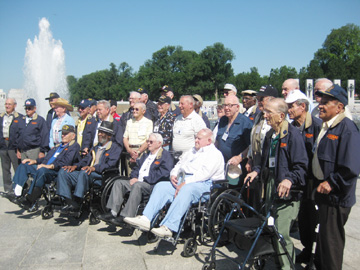Chesapeake Bay's Independent Newspaper ~ Since 1993
1629 Forest Drive, Annapolis, MD 21403 ~ 410-626-9888
Volume xviii, Issue 21 ~ May 27 to June 2, 2010
Home \\ Correspondence \\ from the Editor \\ Submit a Letter \\ Classifieds \\ Contact Us
Best of the Bay \\ Dining Guide \\ Home & Garden Guide \\ Archives \\ Distribution \\ Advertising![]()


The Veterans are the Best Part of the
National World War II Memorial
But their living memories are dying history

The National World War II Memorial — epically situated in the memorial heart of our capital city, on the National Mall between the Lincoln Memorial to the west and the Washington Monument to the east — looks like it will be around for a long time.
It’s solid as a rock, built of granite and brass. It’s as basic as the elements, water and sky, that join with manmade structures in defining its reach.
But the animating force of this great plaza survives now in short time.
Go there on any given day, even Memorial Day if you can get in.
Enter Memorial Plaza through the Atlantic or the Pacific pavilion, named for World War II’s twin theaters of conflict. Look up and see, beneath the heights of the sky, four wing-spread eagles twining a ribbon around a laurel wreath.
Or enter through the curvilinear rampart walls at the north and south, and read the story of America’s mobilization in 24 bas-relief panels sculpted in brass on the ceremonial entrance walls.
Inside, there’s plenty to move your heart: the oval Rainbow Pool and its splashing fountains great and small; the 56 wreath-hung pillars for each of the states and territories that sent their sons and daughters to the conflict; the inscriptions of lofty words; the roll of battles; the Freedom Wall with its Field of Gold Stars, 4,000 to represent the 400,000 Americans who died in this war.
None of those mighty, solid works holds a candle to the ancient men who shuffle with you through this sacred space. Some roll in wheelchairs; some lean on walkers; many hold the arm of a wife, daughter or escort. Their bodies are gaunt or paunchy. Their cheeks are hollow, their jowls wattled, their noses veined and bulbous.
They are old men. You have to look hard to see in them the boys who escaped from the predictability of life in Maryland or Maine or Missouri or Montana to see the world.
They saw the war. You cannot imagine what they saw. But you know from their shell-shocked look that they are seeing it again.
They are awed and daunted, and their hearts are overflowing.
At the other end of life, kids rush into the memorial, shouting with joy to be free, rushing like tanks down the ramps, chinning themselves on the state pillars, posing for photos with arms outstretched as if they owned the world.
Sometimes the two meet, the kids and the old men who were hardly more than kids when they rushed into that great war.
I saw such a meeting the other day, when I visited the memorial in the company of 30 veterans from 10 midwestern states, Ohio to Texas. They could have made the trip on one of the many Honor Flights (www.honorflight.org) routinely flying aging veterans here from all over America. These men, however, were not only veterans but laborers, and they had made the great journey as honored guests of their union, Laborers International Union of North America.
Like so many veterans who come on these sponsored trips, they said they’d never have managed on their own. They said it is the experience of a lifetime.
Far from their homes, in this big city and this hallowed plaza and caught up in memories, the veterans hardly expected to be mobbed by kids, like stars by paparazzi. Yet they were. Gangs of kids surrounded the old men, wanting to know Were you there? Begging to hear their stories.
Eleven hundred World War II veterans die each day, according to the Department of Veteran’s Affairs. Their living memories are dying history.
So you had better get there soon, perhaps this Memorial Day, and be smart and inquisitive and connective like the kids, because when these old men are gone, this vast memorial space will be empty.
© COPYRIGHT 2010 by New Bay Enterprises, Inc. All rights reserved.
